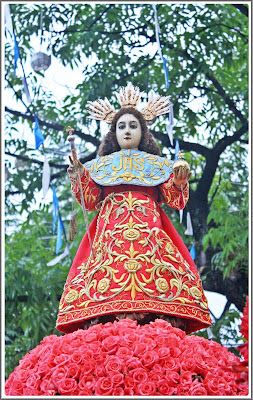The Meek Santo Niño de Marikina
 |
| Santo Niño de Marikina |
The image
The ivory image of Santo Niño de Marikina is presented as a regal prince ready to take his dominion. The image has a archaic face that adds a certain charm to it's beholder. He sports long curly hair with the diagnostic Tres Potencias, vested with an array of vestments given by his devotees for years and holds a globus cruciger and a scepter - the standard symbols of rulership.
 |
| Santo Niño de Marikina |
As of this writing there were no existing documents to determine the origin of this miraculous image and how the devotion to the Holy Child started in Marikina. On the other hand, a pastoral report written in 1905 that was kept in "Parroquia de Marikina" that would later be known as the Diocesan Shrine of Our Lady of the Abandoned of Marikina that gave an early mention of the existence of the Santo Nino. In this particular report, the existence of the Chapel or "Visitas" in the area were mentioned explicitly: Nuestra Señora de la Inmaculada Concepcion (now a Parish), Santo Niño, San Roque and San Antonio de Padua.
In connection with these records, it also noteworthy that in the parish's fiesta program in 1960, one of the "Patron de Barangay" images that joined the procession is that of the Santo Niño along with the images of San Antonio de Padua, San Roque, Santa Elena, Santo Niño de Pasion, San Isidro Labrador and Nuestra Señora de los Desamparados de Marikina.
 |
| Santo Niño de Marikina |
The devotion
The Feast of Santo Niño de Marikina are held twice during the month of January - first during January 1 as the Barangay fiesta and Third Sunday of January, the Liturgical feast of the Child Jesus in the Philippines. On his liturgical feast day, the image is brought out to the Shrine of Our Lady of the Abandoned in Marikina for it's fiesta mass and procession. During the last day of May, the image also comes out in procession along with other patrons of different barangays under the jurisdiction of the Shrine for the Panapos procession - the closing procession of the festivies in honor of Our Lady of the Abandoned, Patroness of Marikina City.
The devotion to the Santo Niño de Marikina grew in the recent years and locals continued to flock his chapel to seek his divine guidance. In His quiet presence in the city of Marikina, he continued to guide the city as it progress over the years and never ceases to grant favors to his devotees every time someone needs His help.
 |
| Facial detail of Santo Niño de Marikina |
Mahal naming Santo Niño de Marikina, Panginoong Hesus at aming Tagapagligtas. Ikaw ang masunuring anak ng Diyos Ama. Ikaw ang aming buhay at pag asa. Nagpapasalamat kami sa lahat ng pagpapala at walang hanggang biyaya Mo sa amin. Pinupuri Ka namin dahil Ikaw ang tunay na Diyos naming mahihina at dukha.
Mahal naming Santo Niño de Marikina, sa tulong ng Iyong ina at amin ding Inang si Maria, patuloy Mo kaming buklurin at pag kaisahin bilang isang Simbahang Katoliko dito sa Marikina. Pagpalain Mo po ang aming pamilya at iligtas Mo kami sa masama at anumang sakuna. Bilang isang deboto gawin Mo po akong tapat at banal.
Mahal naming Santo Niño, kahabagan Mo po kami.
References:
Parroquia de Marikina (pastoral report), Parroquia de la Nuestra Señora de los Desamparados, Marikina, 1905.
Our Lady of the Abandoned Parish Fiesta Souvenir Program, Our Lady of the Abandoned Parish, Marikina, 1960.
Interview:
Rodel Enriquez of the Diocesan Shrine of Our Lady of the Abandoned, Marikina City





Comments
Post a Comment